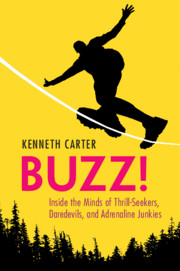Book contents
- Buzz!
- Buzz!
- Copyright page
- Dedication
- Contents
- Preface: My Fascination with Thrill
- Acknowledgments
- 1 What is Sensation-Seeking
- 2 Born to Be Wild
- 3 Faster, Hotter, Louder: The Everyday Life of a High Sensation-Seeker
- 4 Lights, Camera, Action: Sports and Adventure in High Sensation-Seeking
- 5 What About Your Friends: The Relationships of High Sensation-Seekers
- 6 All in a Day’s Work
- 7 The Dark Side of High Sensation-Seeking
- 8 Super Power or Super Problem
- Conclusion
- Book part
- Inventory of Notes
- Index
1 - What is Sensation-Seeking
Published online by Cambridge University Press: 14 October 2019
- Buzz!
- Buzz!
- Copyright page
- Dedication
- Contents
- Preface: My Fascination with Thrill
- Acknowledgments
- 1 What is Sensation-Seeking
- 2 Born to Be Wild
- 3 Faster, Hotter, Louder: The Everyday Life of a High Sensation-Seeker
- 4 Lights, Camera, Action: Sports and Adventure in High Sensation-Seeking
- 5 What About Your Friends: The Relationships of High Sensation-Seekers
- 6 All in a Day’s Work
- 7 The Dark Side of High Sensation-Seeking
- 8 Super Power or Super Problem
- Conclusion
- Book part
- Inventory of Notes
- Index
Summary
Cliff diving isn’t a typical activity for anyone, much less a person who is afraid of heights. But Mike,1 a 20-year-old intern living in Atlanta, does it as often as he can, despite this fear. He’s also gone skydiving at least four times. The first time, he was a little disappointed. “I actually wasn’t scared at any point, which was weird.” The second time Mike actually told his guide, “The last guy failed to scare me, so I want you to scare me.” Even by his own reckoning, this isn’t something you should say to a skydiving coach. I couldn’t help but ask, “Well, did he scare you?” “Yeah,” he said, “he went about it very cleverly. Beforehand he told me that when they’ve got somebody who isn’t cooperating (apparently some people will grab the guide’s arms or something when they should be pulling the chute), they spin the person around really fast. Because this increases G-force, the person passes out and the instructor can get them safely to the ground. So we’re in the middle of free fall and that is basically what he does to me. He takes my hand and bends it down slightly, so I start spinning extraordinarily fast in one direction.
- Type
- Chapter
- Information
- Buzz!Inside the Minds of Thrill-Seekers, Daredevils, and Adrenaline Junkies, pp. 1 - 26Publisher: Cambridge University PressPrint publication year: 2019



